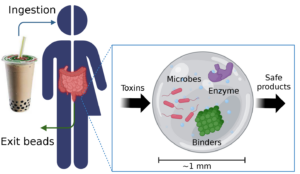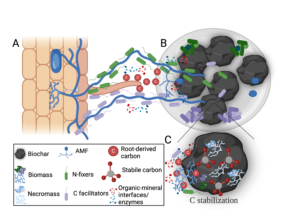Hydrogel Technology in the Winkler Lab
A hydrogel is formed when a solution of hydrophilic polymer chains is cross-linked and thus traps the water present in the solution in a soft semi-solid state. This happens when you cook and egg or make Jello, both examples of natural hydrogels. One of the most widely used hydrogels is another natural material, calcium alginate, made from the sodium salt of the acidic carbohydrate alginic acid (sodium alginate or SA) produced by various seaweed species. Hydrogels can also be made from synthetic polymers such as PEG acrylates, acrylamide, hydroxyethyl methacrylate (HEMA) and polyvinyl alcohol (PVA). Such synthetic polymer materials are used to make soft contact lenses for instance.

Many of the projects pursued over the last 5 or 6 years in the Lab have made use of hydrogels, mostly for encapsulating bacteria and other microbes. Encapsulation of microbes that are to be used in settings like a bioreactor or wastewater treatment plant generally simplifies their handling in these engineered settings. The active organisms can easily be strained out of the liquid medium and reused, or they are easily retained in a continuous flow-through process by allowing them to settle. This is quite advantageous when slow- growing microbes are used in flow-through processes as the slow-growing organisms are otherwise easily washed out and lost. The hydrogel matrix also affords some protection for the microbes against adverse conditions in much the same way that a biofilm does. Microbes that do not normally associate in biofilms can be cultured and then combined in a hydrogel particle to take advantage of their complementary metabolisms, such as when organism #1 converts a substrate into a product that organism #2 then uses to make another product which organism #1 alone can not make. Combining the two organisms together in close proximity in gel particles makes this shared metabolism more efficient by keeping the local concentration of the intermediate product/substrate high. The use of hydrogel encapsulation allows microbial combinations to be made which are otherwise difficult to produce.
We have used hydrogels described in the scientific literature in some projects and have developed custom formulations with specific properties for other projects. One property that any gel used for encapsulating live microbial cells must have is low toxicity to the cells. In addition, the process of forming the gel from the soluble precursor molecule or monomer must not be too stressful to the cells. Some cells are more sensitive than others to the cross-linking chemistry or process used to form gels. This means some experimentation is often required to arrive at a practical approach for a given experiment. Some gels are easy to make and the process is minimally stressful to cells, but the gel may be relatively weak and thus not suitable for some uses. We have developed and used many different gels for different purposes ranging from short-term laboratory experiments to long-term industrial pilot process testing to animal ingestion experiments.
Therapeutic bubble tea project
 Uremic toxins are harmful substances which accumulate in the body when kidney function becomes impaired. Most of these toxins are produced by bacteria in the gut, by our intestinal microbiome. Kidney patients rely on medicine and dialysis to remove these toxins, but the performance of these treatments is limited. Some uremic toxins bind to blood proteins and these are not effectively removed by dialysis and there is no existing treatment on the market. In the bubble tea project, we are using different strains of bacteria capable of absorbing or degrading uremic toxins. The bacteria are encapsulated in gel beads to concentrate the cells and protect them from low pH, digestive enzymes, and other bacteria in the digestive system. These gel beads can carry some cargo (such as bacteria, binders or enzymes) and they travel through the intestines and remove uremic toxins formed by gut microbiome before they can enter the bloodstream hence preventing them from accumulating to toxic levels in the serum. This innovative treatment is called therapeutic bubble tea since kidney patients can drink the gel beads like drinking bubble tea to treat symptoms of kidney disease.
Uremic toxins are harmful substances which accumulate in the body when kidney function becomes impaired. Most of these toxins are produced by bacteria in the gut, by our intestinal microbiome. Kidney patients rely on medicine and dialysis to remove these toxins, but the performance of these treatments is limited. Some uremic toxins bind to blood proteins and these are not effectively removed by dialysis and there is no existing treatment on the market. In the bubble tea project, we are using different strains of bacteria capable of absorbing or degrading uremic toxins. The bacteria are encapsulated in gel beads to concentrate the cells and protect them from low pH, digestive enzymes, and other bacteria in the digestive system. These gel beads can carry some cargo (such as bacteria, binders or enzymes) and they travel through the intestines and remove uremic toxins formed by gut microbiome before they can enter the bloodstream hence preventing them from accumulating to toxic levels in the serum. This innovative treatment is called therapeutic bubble tea since kidney patients can drink the gel beads like drinking bubble tea to treat symptoms of kidney disease.
Harnessing the power of soil micro- and mycobiomes to address widespread environmental issues
 Soil degradation and dysbiosis is a critical global challenge, threatening food security, carbon sequestration, and agricultural sustainability. BioBead is an innovative biodegradable hydrogel technology designed to address soil dysbiosis by restoring microbial balance, enhancing nutrient retention, and promoting plant resilience. By leveraging bacterial-fungal-plant interactions, BioBead facilitates stable soil carbon storage, reduces reliance on synthetic fertilizers, and improves water retention. Our research integrates microbial consortia and hydrogel science to develop a scalable, sustainable approach for improving soil fertility, bioremediation, and climate resilience.
Soil degradation and dysbiosis is a critical global challenge, threatening food security, carbon sequestration, and agricultural sustainability. BioBead is an innovative biodegradable hydrogel technology designed to address soil dysbiosis by restoring microbial balance, enhancing nutrient retention, and promoting plant resilience. By leveraging bacterial-fungal-plant interactions, BioBead facilitates stable soil carbon storage, reduces reliance on synthetic fertilizers, and improves water retention. Our research integrates microbial consortia and hydrogel science to develop a scalable, sustainable approach for improving soil fertility, bioremediation, and climate resilience.
Integrating single-cell wetland microbiome structure, function, and activity to ecosystem-scale biogeochemical fluxes

Wetlands play an essential role in the global carbon cycle, storing about 20% of terrestrial carbon while occupying only 5–8% of Earth’s land surface. They also account for roughly 30% of global methane emissions. However, these ecosystems are increasingly threatened by complex climate feedback controls and anthropogenic perturbations, which can disrupt their carbon balance. Hydrological disturbances—such as drought, flooding, and saltwater intrusion from sea-level rise—can significantly alter sediment biogeochemistry, impacting permanent carbon sequestration capacity and greenhouse gas fluxes. This research integrates fieldwork with laboratory bioreactors to examine how oxygen and sulfate influence the wetland microbiome. By pairing multi-omics approaches (metagenomics, transcriptomics, and proteomics) with measurements of microbial metabolites and greenhouse gas emissions, we aim to improve our understanding of wetland responses to environmental stressors—critical for predicting their role in future changes in weather patterns.
Innovative and sustainable biological wastewater treatment processes

As urbanization increases, wastewater treatment plants must treat higher flows while meeting stricter nutrient discharge limits, often within space-constrained facilities. Traditional activated sludge systems, originally designed for biological oxygen demand removal, now require additional processes for nitrogen and phosphorus removal, increasing reactor volume, energy demand, and chemical inputs. To address these challenges, process intensification—developing more efficient and compact treatment technologies—has become essential. This research investigates two intensification technologies, the Mobile Organic Biofilm (MOB) process and aerobic granular sludge. Lab and pilot scale studies are conducted aimed to advance wastewater treatment intensification, enabling more sustainable, adaptable, and resource-efficient nutrient removal solutions.
SeaO2 Lockers
SeaO2 Lockers has created a novel system for extremely high-density microalgae offshore farming to sequester CO2 at gigatonne scale. The SeaO2 Locker system will lock CO2 for centuries within building infrastructure, and in underground storage. Our offshore farming also offers a platform for extract value-added products (animal feed, fertilizer, pharmaceuticals, medicine, plastics) and food (high value nutrients, protein foods, healthy foods) to offset the CO2 sequestration cost.
